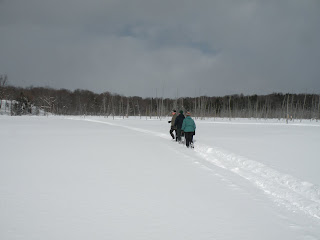Who lives here?
 Introducing the Wood Duck!
Introducing the Wood Duck!(Aix sponsa)
 {A male wood duck on the left and a female on the right}
{A male wood duck on the left and a female on the right}photo credit: Randolph Femmer
I wrote a couple of weeks ago about the Pileated Woodpecker and the importance of cavities. Wood ducks are one of the species that uses cavities made by pileated woodpeckers. However, wood ducks can also be induced to nest in artificial boxes.

Armed with this knowledge, an invitation from a landowner here in Muskoka, a cordless drill, a sharpie, and some wood shavings, a group of us headed out to see for ourselves if any nesting had taken place last spring on this property.
 The incredible volunteers who accompanied me are none other than 3 of the Master Stewards from the Muskoka Stewardship Program. We were invited to this spectacular 100 acre property located in Muskoka to see if there had been any wood duck activity during the past year and prepare the boxes for this coming spring.
The incredible volunteers who accompanied me are none other than 3 of the Master Stewards from the Muskoka Stewardship Program. We were invited to this spectacular 100 acre property located in Muskoka to see if there had been any wood duck activity during the past year and prepare the boxes for this coming spring.

You see, wood ducks like to nest in cavities in wetlands because it makes it very difficult for predators to access their nests. These boxes are located in a 30 acre wetland. It's actually quite an amazing beaver pond. Normally inaccessible, the wood duck boxes had to be put up in winter and we needed the ice to be solid to change the material in the boxes for the coming spring.
Above: Paula unscrews the front of the box...you can see our shadows as we eagerly anticipate the contents of the first box!!
Female wood ducks often return to nest in the place where they were born. There is an increased chance they will use the boxes if they are not dirty from the previous year and also if the material inside is dry.
Our mission for the afternoon: clean out boxes, make observations on each one (amount of eggs inside, other animals that may have used it), and refill the boxes with new material. We also re-labelled the numbers on the 8 boxes from last year and assigned numbers to the 5 new boxes that were put up.
Inside each box the material is compacted down. There are often layers of broken shells and downy feathers. Notice the inside of the front piece that is sitting on the ground. The horizontal lines are carved in so the hatchlings can grab on to climb out before they fledge.
This box has quite a few shells and some feathers. In some of the boxes we could tell it was a wood duck because of the iridescent colour of the feathers.
A close up of the egg shell and some downy feathers.
Here is the crew, with our tools, in front of Box #5. Notice the oblong shape of the entry hole for the wood ducks. This shape is suited for them and is also big enough, but not too big. If you decide to put up boxes of your own, this is an important component. Also important is the forward slanted way they are affixed to the tree.
A beautiful day to get ready for spring and help the wood ducks have suitable nesting spots for when they return this spring. Perhaps we'll return next year to see how they did!
 photo: Mike Sweet
photo: Mike Sweet
Interested in building your own wood duck box?
Follow the same directions as the landowner whose property we visited!
Want to know more about wood ducks?
There are lots of websites:
Hinterland's Who's Who
House Construction Tips
Ducks Unlimited
The Wood Duck Society
 The booklets are unique in that they contain Muskoka-specific, action-oriented information. The project will enhance and preserve the environment through the encouragement of adopted stewardship topics. Topics include Forest management options, Shoreline and native plants, Wildlife habitat, Trail building, and Species at Risk. They will contain action-oriented tips and best practices for cottagers in Muskoka and elsewhere.
The booklets are unique in that they contain Muskoka-specific, action-oriented information. The project will enhance and preserve the environment through the encouragement of adopted stewardship topics. Topics include Forest management options, Shoreline and native plants, Wildlife habitat, Trail building, and Species at Risk. They will contain action-oriented tips and best practices for cottagers in Muskoka and elsewhere.
 Introducing the Wood Duck!
Introducing the Wood Duck! {A male wood duck on the left and a female on the right}
{A male wood duck on the left and a female on the right}
 The incredible volunteers who accompanied me are none other than 3 of the
The incredible volunteers who accompanied me are none other than 3 of the 







 This woodpecker was pecking away in our yard when we got home the other day! We can see he has been working on a couple of the coniferous trees in our yard by the fresh wood chips on the snow.
This woodpecker was pecking away in our yard when we got home the other day! We can see he has been working on a couple of the coniferous trees in our yard by the fresh wood chips on the snow.





